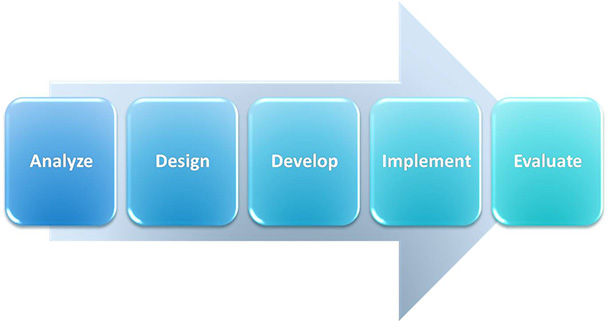My July 2012 column, “Why I Hate Instructional Objectives,” caused a lot of consternation. Some readers understood my point, but others were rather upset. To them, the article was near heresy. Nevertheless, it was a great discussion. So, at the risk of causing another uproar, I’m at it again.
I hate ADDIE.
(If you don’t know what ADDIE is, see Figure 1.)
 Figure 1: The generic ADDIE model we’ve come to know and love (or hate)
Figure 1: The generic ADDIE model we’ve come to know and love (or hate)
Well, I don’t actually hate what ADDIE stands for—a systematic, professional process to develop effective and efficient learning programs—but I am concerned that strict obedience to a single process puts blinders on us, hindering our ability to see alternatives. Here’s why.
ADDIE can be too sequential
Not all ADDIE models are explicitly linear, in a graphical sense. Some are circular, some are square, and some are even three-dimensional. There can be dozens of steps and sub-steps. I’ve seen an ADDIE model take up seven two-inch binders! Some models have arrows in one direction and some have arrows pointing everywhere. Even with so many iterations, perceptions of how to use ADDIE are primarily sequential.
Who says that analysis, design, development, implementation, and evaluation should be done in lockstep order? Shouldn’t we consider evaluation earlier, and circle back to revise what we have done based upon testing, rapid prototyping, or a more agile methodology? Of course. Yet strict adherence to ADDIE sometimes causes people to eschew the next phase until they have done, signed off, and put to bed the last one, even if they think otherwise. This can be very inefficient and costly, but more importantly, it can lead to a lack of divergent thinking on how a particular course should be put together.
ADDIE often focuses on compliance rather than results
Many organizations rely on ADDIE-type models to verify that all the steps of the design and development process have been completed, not necessarily whether the right decisions were made. This may make process folks happy, but it is also unfortunate. When process trumps product, watch out. Creativity and out-of-the-box thinking get lost as the true intent of ADDIE gets hijacked to support a bureaucratic compliance process. When management is more interested in whether all the boxes are ticked than what learning strategies are employed, or if they worked, and when evaluating actual course effectiveness waits until the first offering, when changes are costly and organizationally more difficult to make, you get what you might expect: lots of courses with hundreds of pages of exacting ADDIE documentation, but in the classroom, or online, everything looks pretty much the same.
ADDIE can be painfully slow
It can often take months to produce ADDIE-compliant documentation, not to mention ADDIE-compliant courses. Who has that kind of time anymore? Compliance has its virtues, but speed isn’t one of them. How much time can you devote to an overly formal, structured process, requiring lots of non-courseware documentation? If this describes your work, how can you make it go faster, without jeopardizing quality, and, if you can, does this change your methodology to something newer and more adaptive?
Design is often the stepchild of ADDIE
Can you really use a sequential, step-by-step process to design high quality training? Yes, the process can prescribe what you should do: writing objectives, asking questions, providing practice, etc., but how well those design elements are actually implemented is as much art as science, and as much experience as process, as any good instructional designer will tell you. Instructional design and ADDIE are not the same thing; instructional design is much more, and we get into trouble when we confuse the two. Creativity, heuristics, experience, best practices, trial and error, experimentation, and even informed hunches play a role. You won’t find them in most ADDIE applications. And, as we are discovering, this problem can be exacerbated in an eLearning project.
ADDIE can inhibit non-ADDIE thinking
Perhaps the biggest concern about ADDIE is that it’s been blasted into our heads, and into our practice for so long, we may not just take it for granted, but take it for gospel. “ADDIE is how we do it; it’s how we’ve always done it; and it’s how we’re going to do it in the future.” Spoken or unspoken, is this a healthy attitude? Does it limit our agility to respond to changing learning needs? Does it move your organization, or the field forward? If you rise up to innovate, would the process slap you down? In our drive to make our design process simple and consistent, have we inadvertently made it too simplistic and too rigid (they are not mutually exclusive)?
ADDIE comes trippingly off the tongue. It’s easy to explain. It’s easy to document. It looks good on our posters, flowcharts and design manuals. It’s comfortable; perhaps too comfortable. This is a question every training organization should ask. Is ADDIE serving our needs well? Are there pieces missing? Would we benefit from a more adaptable approach?
Some learning and development organizations make ADDIE work by taking it in a more flexible direction, with less focus on process and more on outcomes. But for too many organizations, ADDIE is the law. Sure we must analyze performance problems, design great learning, and get it developed. We must implement it seamlessly and cost-effectively, and we sure better know if it’s working. But there’s more to it than five boxes and a few arrows … much more. So let’s keep the good parts of what ADDIE represents but throw off the shackles that hold us to the belief that the ADDIE way is the only way.
There are lots of insightful voices on the state of instructional design models, like Allison Rossett and Michael Allen. There’s even a compilation of articles and posts on this debate. So now it’s your turn. Agree, disagree, or have a new perspective? Have at it.



